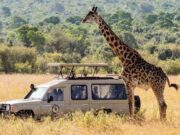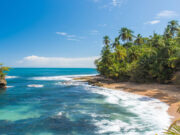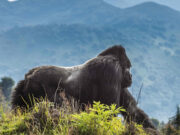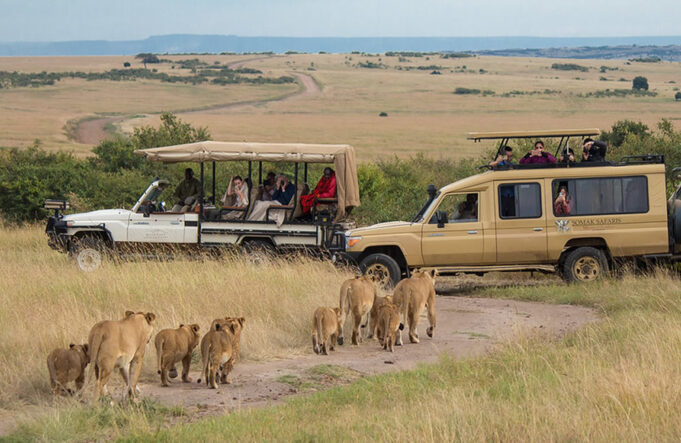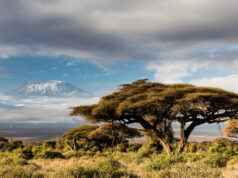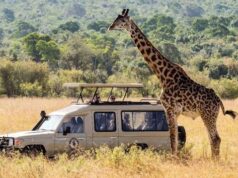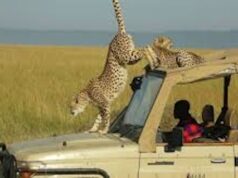Tanzania has three main safari areas, the Northern and Southern Circuits, and Western Tanzania. Travelling between each is a challenge, so most visitors tend to stick with just one. Containing the Serengeti and Ngorongoro Crater, Tanzania’s Northern Circuit is decidedly the headline act. This is where you’ll find both the most prolific wildlife (aka “game”) and serial crowds. Travel to whichever Serengeti corner the spectacular Great Migration currently occupies, and 4×4 vehicles will generally be bumper-to-bumper.
If you’ll happily swap a few animal sightings for extra tranquility and authenticity, head south. The massive main parks here, Selous and Ruaha, are untamed, multi-dimensional expanses where tree-clogged waterways give way to parched plains. You have to work harder to see wildlife, but spying other humans is also rare.
The still-wilder west offers equally good game (including the Mahale Mountains’ chimpanzees) blended with serious remoteness. Parks like Katavi are the preserve of long-term Tanzania safari junkies seeking a new fix.
Consider The Following Tips;
- Choose the Right Time to Visit
Research the best time to visit Tanzania for primate safaris. Different seasons may offer different opportunities for wildlife viewing.
Peak seasons often coincide with the dry months, as wildlife tends to concentrate around water sources.
- Select the Right Safari Package
Choose a safari package that includes primate experiences. Look for tours that specifically highlight chimpanzee or gorilla trekking in addition to traditional game drives.
- Research National Parks and Reserves
Tanzania is home to various national parks and reserves that offer primate safaris. Research parks like Gombe Stream National Park or Mahale Mountains National Park for chimpanzee trekking.
For gorilla trekking, consider combining your Tanzania safari with a visit to neighboring countries like Rwanda or Uganda.
- Work with Reputable Tour Operators
Choose a reputable tour operator that specializes in primate safaris. Ensure they have experienced guides and a good track record of providing quality wildlife experiences.
- Prepare for Physical Activity
Primate trekking can involve some physical exertion. Make sure you’re in good health and physically prepared for activities like trekking through forests and up hills to reach primate habitats.
- Get the Necessary Permits
Obtain the required permits for primate trekking in advance. Permits are often limited and should be secured well ahead of your travel dates.
- Pack Appropriate Gear
Pack suitable clothing and gear for primate safaris. This may include sturdy hiking boots, long pants, long-sleeved shirts, a hat, and insect repellent.
Consider bringing a good pair of binoculars and a camera with a zoom lens to capture memorable moments.
- Follow Ethical Wildlife Viewing Practices
Adhere to ethical guidelines for wildlife viewing. Maintain a respectful distance from the primates, avoid direct eye contact, and follow the guidance of your guides.
- Combine Primate Safaris with Traditional Game Drives
While focusing on primate experiences, consider combining your safari with traditional game drives to witness a diverse range of wildlife in Tanzania.
- Immerse Yourself in the Local Culture
Take time to learn about the local culture and communities surrounding the primate habitats. This adds a rich dimension to your safari experience.
- Stay Informed About Conservation Efforts
Stay informed about conservation efforts in the area and consider supporting organizations that work towards the protection of primates and their habitats.
Below are some of the Attractions in Tanzania That Attract Tourists
Serengeti National Park
The Serengeti National Park is a wide treeless endless savannah plain where 2 million animals live or pass through in quest of new grasses. It is best known for the yearly wildebeest migration, you’ll also view the Big Five animals like lions, elephants, leopards, black rhino, and buffalo, and nearly 500 bird species in the Serengeti.
Every year, tens of thousands of tourists visit the Serengeti. The months of December through June are ideal for animal watching in Serengeti National Park. The rainy season lasts from March to May, and the coldest months are from June to October.
Hike Mount Kilimanjaro
Hiking up Kilimanjaro means going from the heat of the equator to the frigid cold of the arctic in just six to eight days. Kilimanjaro is a microcosm of many of the world’s habitats and climates. Trekkers climb through five climatic zones as they ascend 5895 meters. Climatic zones are defined as regions with generally consistent temperature and precipitation. The first 1800 meters of the mountain was once dense with forests but is now cultivated with plantations and pastures in this area of heavy rainfall and rich volcanic soils.
Mount Kilimanjaro can be climbed at any time of year; however, the peak season is from late June to October, when it is dry.
Ruaha National Park
Ruaha National Park is the largest national park in Tanzania; the park has the highest concentration of wildlife in Tanzania, Ruaha National Park inhabits about 10% of the world’s lion population, the park has a concentration of elephants, herds of buffalo and gazelles, there are more than 574 bird species namely Crested Barbet, pale-billed hornbill, racket-tailed, Dickinson kestrel among others.
River Ruaha is the main source of water to wildlife in the Park. Other animals that inhabit the park include leopard, zebra, giraffe, lesser kudu, greater kudu, wild dogs, black-jackal, hyena, waterbuck, bushbuck, impala, and Hartebeest. The Park is one of the least busy places to visit in Tanzania. Kindly contact us for more info about Safaris in Tanzania.
Lake Manyara National Park
The landscape of Lake Manyara National Park includes forest, woodland, grasslands, and wetlands. Lake Manyara Park’s main attraction is its enormous population of elephants, tree-climbing lions, and hippos, which may be seen at a much closer range than in other parks.
Water covers two-thirds of the park about 230 km2 – Lake Manyara, at certain times of the year, is home to thousands of flamingos as well as other diverse bird life namely Narina trogon, crowned hornbill, Schalow’s turaco, emerald cuckoo, crowned eagle, silvery checked hornbill, knob-billed duck, winged goose, Hottentot teal, red-billed duck, scary francolin, great flamingo, lesser flamingo, mourning collared dove, red-eyed dove, ring-necked dove, laughing dove, African jacana, black-winged stilt, water thick-knee, African palm-swift, little swift, glossy ibis, African sacred ibis, white-backed vulture, bateleur, black chested snake eagle, hadada ibis, African spoonbill, striped kingfisher, little bee-eater, greater honeyguide, red-backed shrike, northern fiscal, pied crow, willow warbler among others.
Mafia Island
Divers and snorkelers worldwide visit Mafia Island to explore the undersea world protected by the Mafia Island Marine Park. Although the best months for diving are October to March, the best months for weather on Mafia Island are May to October. March and April are rainy.
Mafia Island Marine Park contains coral gardens, a diverse fish population, and a laid-back diving ambiance. There are several bird species and over 400 fish species can be found in the area. Mafia Island is also a traditional breeding place for critically endangered green turtles.
Mafia is also a popular destination for deep-sea fishing, particularly for tuna, marlin, sailfish, and other large game fish.
Ngorongoro Conservation Area
The Ngorongoro Conservation Area, located between the Serengeti and Lake Manyara, is home to the iconic volcanic Ngorongoro Crater and is one of Tanzania’s most popular wildlife viewing places. This massive volcanic crater offers a constant supply of water, attracting thousands of species that stay in the area instead of moving to search for water.
Visitors come here mostly to see huge animals and birds. Thousands of animals may be seen on the crater floor, including lions, elephants, rhinos, Thomson’s gazelles, and buffaloes, but wildebeests and zebras account for more than half of the animals that live in the Ngorongoro Crater.
Tarangire National Park
Tarangire National Park is an excellent place to see animals. It is preferable to visit during the dry season, which lasts from July to September when the animals congregate along the river.
Tarangire National Park boasts one of the biggest concentrations of migratory animals throughout the dry season. The lagoons in Tarangire National Park are filled with wildebeest, zebra, buffalo, impala, gazelle, hartebeest, and eland.
The park is also well-known for its big elephant population and the baobab trees that dot the grassland landscape. Tarangire National Park is ideal for bird watching, with over 300 species recorded namely superb starling, lilac-breasted roller, yellow-billed stork, African hoopoe, open billed stork, ostrich, black-necked weaver, yellow-necked spur-fowl, woodland kingfisher, black-headed heron, pygmy falcon, African marsh harrier, white-faced whistling duck, red-billed hornbill, northern white-crowned shrike among others.
Zanzibar
Zanzibar, commonly known as Unguja, is a popular tourist destination in Tanzania noted for its magnificent beaches. This island is part of the Zanzibar Island chain, which includes the islands of Zanzibar and Pemba. It features some of the best beaches in the world.
The surf changes depending on which side of the island you’re on, but tourists can expect smooth white beach and crystal shallow water, as well as traditional boats lining the beachfront.
Stone Town, Zanzibar’s medieval city is famed for its old Arabian mansions, narrow alleyways, and bustling port.
Conclusion
A vibrant and beautiful country with exceptional parks and reserves, Tanzania is blessed with the winning combination of unparalleled game viewing and dazzling tropical beaches. Contact Primate Safari Experiences for more information about exploring Tanzania and making your trip a memorable one.



